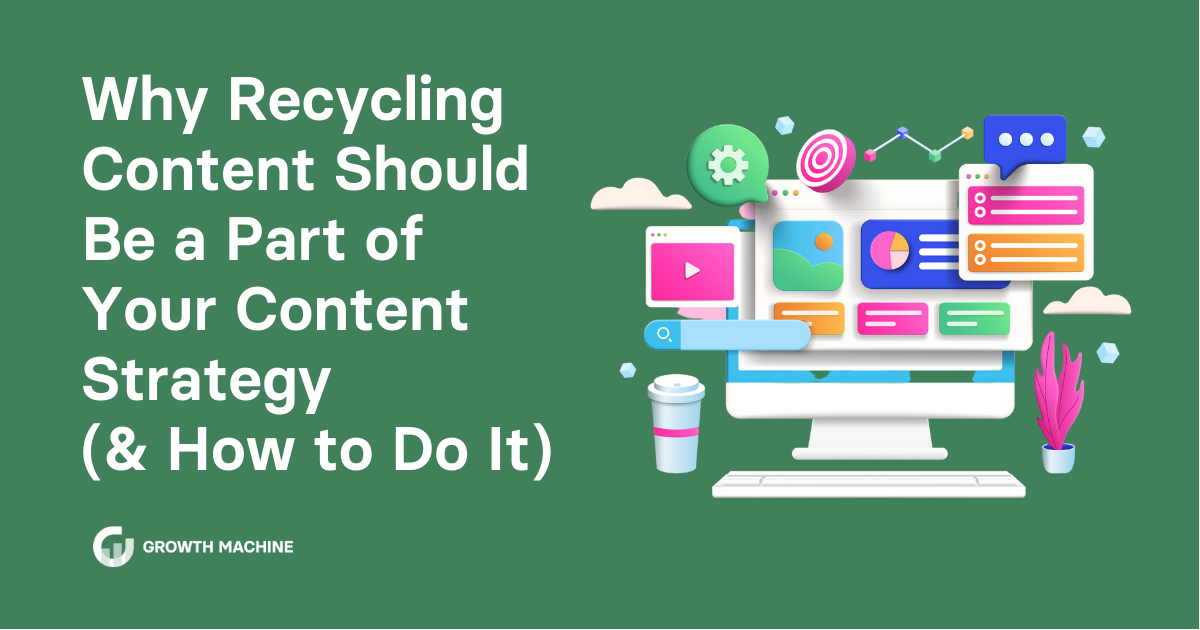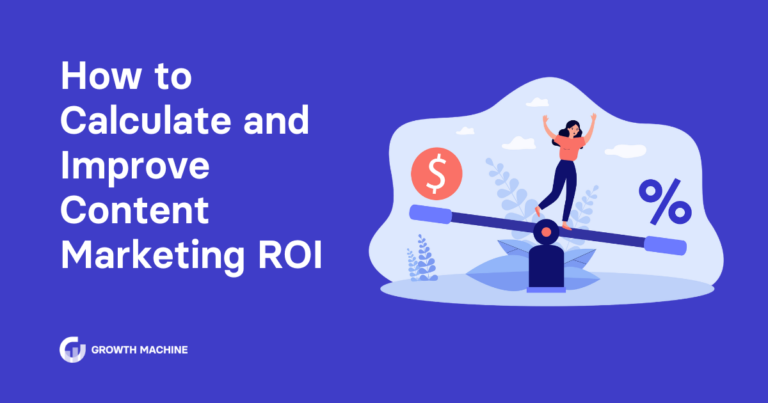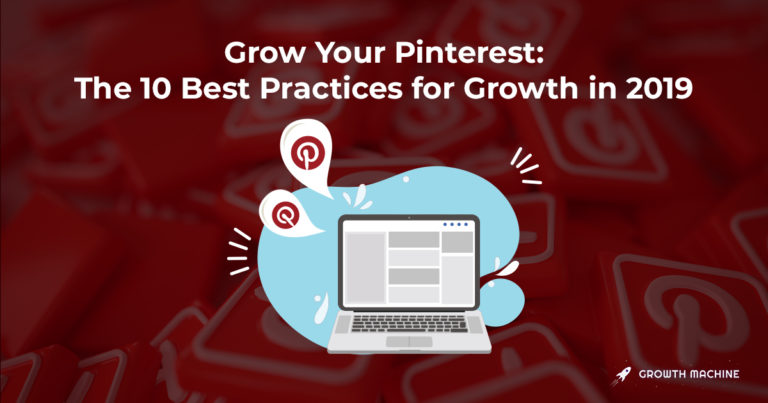Why Recycling Content Should Be a Part of Your Content Strategy (& How to Do It)
Every piece of content you create needs to be recycled into at least one other medium — and that’s just the bare minimum.
Here’s why: Executing a content strategy takes time, money, and manpower. Recycling content — or repurposing content — into a different format or platform allows you to reach new audiences and present your ideas in a fresh way without having to start from scratch.
It’s easy to get caught up in the day-to-day tasks of growing a business. But when you take a step back every so often to ask yourself, “What story do we want to tell?” and then reverse-engineer that answer into a series of blog posts, webinars, and social media posts, you get the best chance to connect with your customers and — hopefully — convert to sales.
Below, we dive into how to recycle your content without sounding redundant. We explain why content recycling serves not only your audience but also your bottom line, and how to use data to determine which channels are most effective.
If you want to learn this in a visual format, check out our YouTube video:
5 Reasons Why You Should Recycle Existing Content
If you read the above paragraphs and thought, “But… wouldn’t recycled content be annoying? Wouldn’t I sound repetitive?” think again.
With the way today’s search engines and social media platforms operate, it’s likely that a good portion of your audience isn’t even seeing your digital content. Just let that sink in.
Take Instagram, for example. Back in 2016, it is estimated that people were missing as much as 70% of all posts in their feeds, including almost half of the posts from their close connections. While Instagram has made changes to its ranking algorithms in response to that issue, the fact remains that many of your followers may not see your social media content when you post it.
The same goes for SEO. If your web traffic has been on the decline lately, it could be because you’re not sharing content strategically to target different keywords and topics. And unfortunately, that means your target audience isn’t seeing your content.
With so much content out there, your best shot at getting seen online is to show up consistently with high-value content. Recycling content helps you do exactly that — you can produce more content and repurpose it into formats that are targeted to your audience’s interests (more on this below!).
Here are more reasons why content recycling is critical to the success of your digital marketing strategy:
1. Recycling Content Allows You to Better Serve Your Target Audience
The best way to approach content creation is to let psychology inform your content strategy. As a content marketer, your number one job is to get into the minds of your consumer base and speak directly to them. When you understand how your audience thinks and behaves, one thing will become abundantly clear:
No one consumes content exactly the same way.
Your audience is segmented by how they consume information. Some people like reading meaty blog posts, while others enjoy scrolling through tweets. Some enjoy skimming email snippets, and others prefer listening to podcasts. Your job is to meet each consumer where they’re at and speak to them through their preferred medium.
Just published a new article on your company blog? Great — see if you can pull four shareable social media posts from that single piece of content. Or hand the blog post off to your sales team, and see if they can wordsmith it into a new pitch deck. If the new slide deck resonates with potential clients, see if one of your executives wants to host a breakout session on the same topic at an upcoming conference.
Suddenly, your single blog post multiplies into seven pieces of content. It’s a strategy we follow here at Growth Machine and one we advise our clients to use, as well.
2. Recycling Content Can Boost Your Search Rankings
Search engines favor content based on two important factors:
- the relevance of the content
- the domain authority, or credibility, of a webpage
Recycling content into different formats and platforms, as well as updating and republishing existing web pages or blog posts, can help to attract more traffic and backlinks — important factors in building credibility or trust with search engines. It also allows you to target different keywords and topics, which can improve your overall relevance to search queries.
Case in point: Recycling your content allows you to generate more website traffic without constantly putting time and effort into creating new content.
If you’re looking to incorporate content recycling into your marketing strategy and boost your search ranking, check out this helpful article for tips. Or better yet — hire a search engine optimization agency that knows what they’re doing.
3. Recycling Content Helps Support Your Brand’s Overall Narrative
An effective content strategy should convert more leads to sales, making your marketing campaigns more effective.
Content is about sharing a story — the narrative you want your company to communicate. By breaking apart one idea and presenting that idea in images, charts, social media posts, and white papers, you are able to support that narrative from an all-encompassing view.
One of our favorite ways to transform recycled materials into great content is to see where you can make old blog posts more interactive. Rather than present a laundry list of paragraphs and bullet points, strive for interactive blog posts complete with slide shows, images, infographics, recordings, and written content.
Putting these different formats together in new ways will generate a 360-degree, multi-level experience of a blog post that’s sure to leave an impression on your customers.
4. Recycling Content Cuts Down on Budget
Repurposing existing content helps preserve your bottom line. Period.
Does recycling a single blog post into infographics, social posts, and webinars sound like a lot of work? Absolutely. This strategy means that when you finish a piece of content, the work is just beginning — you then need to think of new, inventive ways to get your point across.
At the same time, what sounds easier: optimizing and reposting one original article seven different ways or writing seven completely new posts? We’ll take the former every time.
If you’re looking to trim extra costs and scale faster, recycling content is the answer. By reducing the need to create new content from scratch (which is time consuming and expensive), you can funnel your financial resources into other areas of your business.
5. Recycling Content Expands Your Content’s Longevity
Let’s talk about creating successful content for a second. Any experienced writer or marketer can produce good content, but what takes it from good to great is an effective distribution strategy.
A solid content distribution strategy includes repurposing and recycling your brand’s best content so it can be seen by the widest audience possible. By repacking the same information in new ways, such as infographics, videos, or social media posts, you can attract a wider range of viewers and increase a single piece of content’s reach for years to come.
Additionally, it’s far easier to reuse existing content than to exhaust creative resources by coming up with new ideas every time, especially if you have a small team or limited resources. Putting that time and energy into refurbishing your best content helps your content stay relevant and fresh, and ensures that your online audience hears your brand’s message, even if they missed your original piece of content.
How to Recycle Content in a Way That Resonates With Your Audience
There are seemingly countless ways to reuse popular content in various mediums. Below, we dive into several tactics to do that.
- Create sound bites for social media: These days, there are lots of free tools that allow you to splice and dice audio into bite-sized audiograms. We like using Wavve.co to take interesting quotes or sound bites from podcast episodes and post them on Twitter. This helps each insight stand out on its own, and it nudges users to download the episode.
- Tease content on other publishing platforms: If your blog holds the answers to peoples’ burning questions, see if someone posted about it on Quora. Respond to the original question, then link to your blog post. You can also take an insight from your blog post and use it in a LinkedIn post, or truncate the blog post and tease it in a LinkedIn article. Long-form content plays well on LinkedIn.
- Create original infographics: Original research translates into highly shareable content (HubSpot and Mailchimp are experts at this). If you publish a numbers-heavy research post, make it more digestible through visual content — such as infographics created in Photoshop or Canva — then share it across social media.
- Expand on content in ebooks and online courses: If you stick to a consistent content marketing strategy, you will have an entire library of content by the year’s end. Weave relevant pieces into a cohesive ebook or free course, which readers can download in exchange for their email address.
- Put your best blog posts into a drip campaign: When people join your email list, demonstrate your content’s value by starting them in a Welcome sequence that showcases your best content.
- Transform testimonials into blog posts: No one is better suited to sell your services than your happiest clients. Take a two-sentence testimonial and flesh it out into a case study. Then, elaborate on the case study to create new blog content. Or, even have your client do a guest post!
- Package your new content into your newsletter: You may already have a weekly email newsletter. Consider adding a monthly roundup to the mix to make sure your subscribers see the content. While you won’t forget about that blog post you wrote three weeks ago, there’s a good chance the majority of your audience will, or that they won’t see it otherwise.
Use Data to Understand Which Recycled Content Best Converts
We stated above that content marketing is human psychology. But psychology is based on science and data — not just theories.
Use Google Analytics and other tools to understand how your audience consumes content. There won’t always be metrics to understand exactly which types of content your audience prefers, but certain facts and figures can help you arrive at an educated guess.
To do this effectively, examine how much time your audience is spending on each piece of recycled content. This will help you gauge whether people are scanning a few paragraphs or taking the time to really digest the information in a blog post. You can also use heat maps to understand which particular landing pages a new audience member arrived on and how that individual traveled throughout your website.
The same goes for social media. Check out performance metrics like views, reach, shares, and saves to see what posts are truly resonating with your audience.
At Growth Machine, we extract insights from the data points across Google Analytics, social media, and ConvertKit. We look at which blog posts are driving users to additional pages or to our Contact Us page, then flag those content ideas for future social media or email campaigns.
Ultimately, making data-driven decisions about which types of content to recycle will do wonders for your online engagement and conversions in the long run.
Recycling Content Isn’t Redundant — It’s a Way to Better Serve Your Audience
Many companies make the mistake of following the “one and done” approach to content marketing. They invest precious time, money, and energy into crafting original content, then become disappointed when it doesn’t convert.
To better connect with your audience, every piece of content you write should be refurbished for multiple mediums, including social posts, slide decks, YouTube videos, and webinars. This allows you to create an all-encompassing view of your argument and connect with your audience across different platforms.
And if you need help with invigorating your content marketing strategy, contact us so we can get started right away!






